Chicago, Illinois, Hgh State Clinic, Hgh Injections, Hrt Doctors
Chicago, Illinois Blood Testing Facilities
 Represents a LabCorp blood testing facility
Represents a LabCorp blood testing facility Represents a Quest Diagnostics blood testing facility
Represents a Quest Diagnostics blood testing facility

Nearby Labcorp Blood Testing facilities:
- Labcorp Center Distance: 0 m, 111 N. Wabash Avenue Ste 1710, Chicago, Cook County, IL, 60602
- Labcorp Center Distance: 1 m, 233 E Erie St Ste 602, Chicago, Cook County, IL, 60611
- Labcorp Center Distance: 12 m, 6191 N Canfield Ave, Chicago, Cook County, IL, 60631
- Labcorp Center Distance: 16 m, 522 W Chestnut Street, Hinsdale, Dupage County, IL, 60521
- Labcorp Center Distance: 18 m, 2601 Compass Rd Suite 135, Glenview Nas, Cook County, IL, 60026
- Labcorp Center Distance: 20 m, 16325 Harlem Ave Ste 110, Tinley Park, Cook County, IL, 60477
- Labcorp Center Distance: 23 m, 10737 W. 165Th Street, Orland Park, Cook County, IL, 60467
- Labcorp Center Distance: 25 m, 1020 E Ogden Ave Ste 208, Naperville, Dupage County, IL, 60563
- Labcorp Center Distance: 28 m, 2338 Higgins Rd, Hoffman Estates, Cook County, IL, 60195
- Labcorp Center Distance: 29 m, 141 E. Irving Park Road, Streamwood, Cook County, IL, 60107
- Labcorp Center Distance: 30 m, 2272 W 95Th Street Ste 100, Naperville, Will County, IL, 60564
- Labcorp Center Distance: 32 m, 387 East 84Th Dr, Merrillville, Lake County, IN, 46410
- Labcorp Center Distance: 34 m, 330 North Madison Ste B2, Joliet, Will County, IL, 60435
- Labcorp Center Distance: 35 m, 2025 S. Chicago Street, Joliet, Will County, IL, 60436
- Labcorp Center Distance: 38 m, 9150 E 109Th Ave Ste C-1, Crown Point, Lake County, IN, 46307
- Labcorp Center Distance: 42 m, 880 Eastport Centre 2Nd Floor, Valparaiso, Porter County, IN, 46383
- Labcorp Center Distance: 49 m, 6530 Sheridan Road, Kenosha, Kenosha County, WI, 53143
- Labcorp Center Distance: 76 m, 3515 N Main St. Ste 2, Mishawaka, St Joseph County, IN, 46545
- Labcorp Center Distance: 79 m, 12555 W National Ave, New Berlin, Waukesha County, WI, 53151
- Labcorp Center Distance: 80 m, 1502 S. Layton Blvd, Milwaukee, Milwaukee County, WI, 53215
- Labcorp Center Distance: 82 m, 756 N 35Th St, Milwaukee, Milwaukee County, WI, 53223
- Labcorp Center Distance: 84 m, 2645 N Mayfair Rd Suite 110, Milwaukee, Milwaukee County, WI, 53226
- Labcorp Center Distance: 85 m, 3040 N 117Th St 210, Wauwatosa, Milwaukee County, WI, 53226
- Labcorp Center Distance: 86 m, 8500 W Capitol Suite 201B, Milwaukee, Milwaukee County, WI, 53222
- Labcorp Center Distance: 95 m, 136 N Main St Suite 309, Thiensville, Ozaukee County, WI, 53092
Nearby Quest Blood Testing facilities:
- Quest Center Distance: 0 m, 111 N Wabash Ave, Chicago, Cook County, IL, 60602-3063
- Quest Center Distance: 2 m, 1460 N Halsted St, Chicago, Cook County, IL, 60642-2605
- Quest Center Distance: 4 m, 2800 N Sheridan Rd, Chicago, Cook County, IL, 60657-6118
- Quest Center Distance: 8 m, 610 S Maple Ave, Oak Park, Cook County, IL, 60304-1091
- Quest Center Distance: 9 m, 4801 W Peterson Ave, Chicago, Cook County, IL, 60646-5725
- Quest Center Distance: 10 m, 800 Austin St, Evanston, Cook County, IL, 60202-3439
- Quest Center Distance: 13 m, 4709 W Golf, Skokie, Cook County, IL, 60076-1258
- Quest Center Distance: 15 m, 1600 Dempster St, Park Ridge, Cook County, IL, 60068-1172
- Quest Center Distance: 16 m, 534 Chestnut St, Hinsdale, Dupage County, IL, 60521-3175
- Quest Center Distance: 18 m, 2551 Compass Rd, Glenview, Cook County, IL, 60026-8042
- Quest Center Distance: 19 m, 1113 Fairview Ave, Westmont, Dupage County, IL, 60559-2709
- Quest Center Distance: 21 m, 7530 Woodward Ave, Woodridge, Dupage County, IL, 60517-3100
- Quest Center Distance: 22 m, 303 E Army Trail Rd, Bloomingdale, Dupage County, IL, 60108-2169
- Quest Center Distance: 23 m, 8840 Calumet Ave, Munster, Lake County, IN, 46321-2546
- Quest Center Distance: 24 m, 808 E Woodfield Rd, Schaumburg, Cook County, IL, 60173-4714
- Quest Center Distance: 25 m, 19070 Everett Blvd, Mokena, Will County, IL, 60448-2073
- Quest Center Distance: 27 m, 640 S Washington St, Naperville, Dupage County, IL, 60540-6693
- Quest Center Distance: 28 m, 2500 W Higgins Rd, Hoffman Estates, Cook County, IL, 60169-7208
- Quest Center Distance: 29 m, 565 Lakeview Pkwy, Vernon Hills, Lake County, IL, 60061-1839
- Quest Center Distance: 33 m, 24600 W 127Th St, Plainfield, Will County, IL, 60585-9507
- Quest Center Distance: 34 m, 310 N Hammes Ave, Joliet, Will County, IL, 60435-5676
- Quest Center Distance: 35 m, 22285 Pepper Rd, Barrington, Lake County, IL, 60010-2538
- Quest Center Distance: 36 m, 15 Tower Ct, Gurnee, Lake County, IL, 60031-5708
- Quest Center Distance: 37 m, 813 N. Porter Campus Dr, Valparaiso, Porter County, IN, 46383-8947
- Quest Center Distance: 42 m, 260 E Congress Pkwy, Crystal Lake, McHenry County, IL, 60014-6235
- Quest Center Distance: 45 m, 1100 W Veterans Pkwy, Yorkville, Kendall County, IL, 60560-4728
- Quest Center Distance: 50 m, 10117 74Th St, Kenosha, Kenosha County, WI, 53142-7533
- Quest Center Distance: 55 m, 3244 Sycamore Rd, Dekalb, Dekalb County, IL, 60115-4941
- Quest Center Distance: 61 m, 2500 Niles Rd, Saint Joseph, Berrien County, MI, 49085-3272
- Quest Center Distance: 73 m, 641 Highgrove Pl, Rockford, Winnebago County, IL, 61108-2506
- Quest Center Distance: 75 m, 16597 State Road 23, South Bend, St Joseph County, IN, 46635-1461
- Quest Center Distance: 76 m, 5901 E Riverside Blvd, Rockford, Winnebago County, IL, 61114-4935
- Quest Center Distance: 84 m, 2600 N Mayfair Rd, Wauwatosa, Milwaukee County, WI, 53226-1309
Chicago Hormone Replacement Therapy Services
Could Hormone Optimization and Restoration be the key to improving your health and wellness, and potentially extending your life? Hormone Balance is one of the key aspects of preserving one's health, and as Hormone Levels fall out of balance, this can increase the risk of a wide variety of health conditions, and it can also lead to symptoms of premature aging. The Conscious Evolution Institute specializes in Physician-Monitored Hormone Therapy for men and women over the age of thirty.
Just by filling out the form on the right or calling the number at the top of the page, you can talk to one of our clinical specialists for a free consultation. They can discuss your options with you and, if you are interested, they can set you up for an appointment with one of our clinical specialists in the Chicago metropolitan area. There you will undergo the necessary preliminary evaluation needed to assess your hormone state, and our specialists will evaluate your clinical data and offer their professional diagnosis. If you qualify for HRT Treatment, we can have your Hormone Prescription mailed directly to your door!
Chicago Human Growth Hormone Therapy for HGH Deficiency
One of the most popular services we provide at the Conscious Evolution Institute is Human Growth Hormone Replacement Therapy. HGH Deficiency is a real and significant medical health issue which can heavily impact health and wellness. Most men and women produce plenty of Growth Hormone to meet their needs when they are young, but around the age of thirty, the body's ability to produce Human Growth Hormone goes into decline.
At first, this decline is slow and nearly imperceptible, but it can become a serious issue over time, impacting physical, mental, and cognitive health. Symptoms of HGH Deficiency include unexplained weight gain, loss of muscle mass, memory and focus issues, fatigue, increased cholesterol levels, and reduced exercise capacity. Human Growth Hormone also maintains healing capacity and keeps the immune system remain strong. With Injectable HGH Therapy, it is possible to restore Growth Hormone Levels to levels associated with the twenties, allowing your body to heal and rejuvenate itself more effectively.
Chicago Sermorelin Therapy for Human Growth Hormone Deficiency
Of course, Human Growth Hormone isn't the only option available to patients. Many physicians feel that Sermorelin Acetate Therapy is a more effective approach to HGH Therapy, getting to the source of the Hormone Deficiency by stimulating the production of natural Human Growth Hormone directly by emulating a hormone produced by the Hypothalamus known as GH-RH, or Growth Hormone-Releasing Hormone.
HGH Therapy is considered quite safe and effective, but there are a few reasons why Sermorelin is considered the better choice for many patients. First, Sermorelin encourages more natural patterns of Human Growth Hormone Release. Second, Sermorelin is cheaper than HGH, and therefore more cost-effective. Third, Sermorelin Acetate can be prescribed off-label, an option not available with HGH Therapy.
Chicago Testosterone Therapy for Low-T
Testosterone Deficiency affects millions of men across the United States. Most men think of Low-T as a sexual disorder, but it's really so much more than that. It is true that Low-T does impair sexual ability and libido, but Testosterone Deficiency also significantly impacts other aspects of male health as well. Testosterone helps maintain optimal body composition and strength, combating frailty, as well as disorders such as hypertension and diabetes. It keeps men sharp and confident.
Low-T is associated with increased feelings of depression and anxiety. Testosterone also encourages strong bones and facilitates cognitive wellness. Testosterone Therapy with Low-T Patches, Creams, and Injections can help men suffering from Andropause feel stronger, healthier, and more like themselves than they have felt in years!
Chicago HCG Injection Treatments for Weight Loss
Have you had trouble maintaining a healthy weight? Has diet after diet failed you in the past? HCG Therapy may be the weight loss option that you've been waiting for. HCG Therapy is a Bio-Identical Hormone Solution that can help you lose as much as thirty pounds in a month through a combination of medical therapy and caloric restriction. Before turning to surgical procedures in an attempt to improve your weight, consider giving us a call and asking about Injectable HCG Therapy and other non-surgical weight loss options.
Chicago, Illinois Information
Chicago is the third largest city in the United States, behind only Los Angeles and New York. The city goes by a number of different nicknames. Chicago is frequently referred to as the Windy City, because its location on the shore of Lake Michigan leads the area to be incredibly windy. The city is also referred to as the Second City, because not long ago, Chicago was considered the second only to New York City in terms of national importance and prominence.
Cities such as Los Angeles and Miami have increased steadily in national importance, but Chicago remains a powerful influence on American culture and the economy. The city is home to one of the busiest airports on earth—O'Hare International Airport, which sees millions of domestic and international travelers every year. Chicago has a strong and complex economy, with an emphasis in the areas of transportation, telecommunications, technology, industry, commerce, and finance.
Chicago has a wide variety of options available for higher education, and many of the best schools in America are located in the city. Among the universities located in Chicago are Depaul, Loyola University Chicago, Northwestern, and the University of Chicago. Chicago also has a strong sports presence with a number of professional sports teams including the Chicago White Socks, the Chicago Cubs, the Chicago Bulls, and the Chicago Blackhawks. The city is widely considered to be one of the best sports towns in the entire United States.
Of course, not everyone is interested in sports. There are tons of things to see and do in Chicago. Among the important and popular cultural landmarks in the city area are the National Museum of Mexican Art, the Chicago Shakespeare Theater, the Lincoln Park Zoo, and the Art Institute of Chicago.
All About Chicago, Illinois Geographic Area
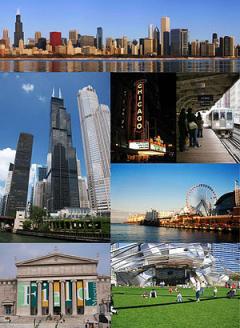
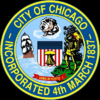
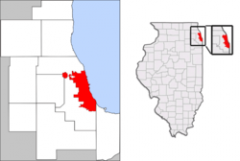
Chicago ( i/ÊcɪËnkÉaËaÉ¡oÊo/ or /ÊcɪËnkÉeËaÉ¡oÊo/) is the third most populous city in the United States. Located in the State of Illinois, the city has approximately 2.7 million residents. Its metropolitan area, sometimes called "Chicagoland", is the third-largest in the United States, after New York City and Los Angeles, with an estimated 9.8 million people. Chicago is the county seat of Cook County, though a small portion of the city limits also extend into DuPage County.
i/ÊcɪËnkÉaËaÉ¡oÊo/ or /ÊcɪËnkÉeËaÉ¡oÊo/) is the third most populous city in the United States. Located in the State of Illinois, the city has approximately 2.7 million residents. Its metropolitan area, sometimes called "Chicagoland", is the third-largest in the United States, after New York City and Los Angeles, with an estimated 9.8 million people. Chicago is the county seat of Cook County, though a small portion of the city limits also extend into DuPage County.
Chicago was incorporated as a city in 1837, near a portage between the Great Lakes and the Mississippi River watershed. Today, Chicago is listed as an alpha+ global city by the Globalization and World Cities Research Network, and ranks seventh in the world in the 2012 Global Cities Index. The city is an international hub for finance, commerce, industry, telecommunications, and transportation, with O'Hare International Airport being the second-busiest airport in the world in terms of traffic movements. In 2008[update], the city hosted 45.6 million domestic and overseas visitors. Among metropolitan areas, Chicago has the fourth-largest gross domestic product (GDP) in the world, just behind Tokyo, New York City, and Los Angeles, and ranking ahead of London and Paris. Chicago is one of the most important Worldwide Centers of Commerce and trade.
Chicago's notability has found expression in numerous forms of popular culture, including novels, plays, movies, songs, various types of journals (for example, sports, entertainment, business, trade, and academic), and the news media. The city has many nicknames, which reflect the impressions and opinions about historical and contemporary Chicago. The best known include: "Chi-town", "Windy City," "Second City",[n 1] "Hog Butcher for the World" and the "City of Big Shoulders".[n 2]
During the mid-18th century, the area was inhabited by a Native American tribe known as the Potawatomi, who had taken the place of the Miami and Sauk and Fox peoples. The 1780s saw the arrival of the first known non-indigenous permanent settler in Chicago, Jean Baptiste Point du Sable, who is believed to be of African and European (French) descent. In 1795, following the Northwest Indian War, an area that was to be part of Chicago was turned over to the United States for a military post by native tribes in concordance with the Treaty of Greenville.
In 1803, the United States Army built Fort Dearborn, which was destroyed in the War of 1812, Battle of Fort Dearborn. The Ottawa, Ojibwe, and Potawatomi tribes had ceded additional land to the United States in the 1816 Treaty of St. Louis. The Potawatomi were eventually forcibly removed from their land following the Treaty of Chicago in 1833. On August 12, 1833, the Town of Chicago was organized with a population of around 200. Within seven years it would grow to a population of over 4,000. On June 15, 1835, the first public land sales commenced with Edmund Dick Taylor as U.S. receiver of public moneys. The City of Chicago was incorporated on Saturday, March 4, 1837.
The name "Chicago" is derived from a French rendering of the Native American word shikaakwa, translated as "wild onion" or "wild garlic", from the Miami-Illinois language. The first known reference to the site of the current city of Chicago as "Checagou" was by Robert de LaSalle around 1679 in a memoir written about the time. The wild garlic plants, Allium tricoccum, were described by LaSalle's comrade, naturalist-diarist Henri Joutel, in his journal of LaSalle's last expedition.
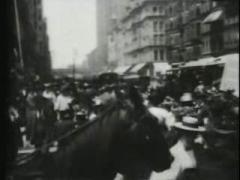
As the site of the Chicago Portage, the city emerged as an important transportation hub between the eastern and western United States. Chicago's first railway, Galena and Chicago Union Railroad, opened in 1848, which also marked the opening of the Illinois and Michigan Canal. The canal allowed steamboats and sailing ships on the Great Lakes to connect to the Mississippi River. A flourishing economy brought residents from rural communities and immigrants abroad. Manufacturing and retail sectors became dominant among Midwestern cities, influencing the American economy, particularly in meatpacking, with the advent of the refrigerated rail car and the regional centrality of the city's Union Stock Yards.
In the 1850s Chicago gained national political prominence as the home of Senator Stephen Douglas, the champion of the Kansas-Nebraska Act and "popular sovereignty" approach to the issue of the spread of slavery. These issues also helped propel another Illinoisan, Abraham Lincoln, to the national stage. Lincoln was nominated in Chicago for the nation's presidency at the 1860 Republican National Convention and went on to defeat Douglas in the general election, setting the stage for the American Civil War.
To accommodate rapid population growth and demand for better sanitation, the city implemented various infrastructural improvements. In February 1856, the Chesbrough plan for the building of the United States' first comprehensive sewerage system was approved by the Common Council. The project raised much of central Chicago to a new grade. While raising Chicago, and at first improving the health of the city, the untreated sewage and industrial waste now flowed into the Chicago River, then into Lake Michigan, polluting the primary source of fresh water for the city. The city responded by tunneling two miles (3 km) out into Lake Michigan to newly built water cribs. In 1900, the problem of sewage contamination was largely resolved when the city reversed the flow of the Chicago River so that it flowed away from Lake Michigan, rather than into it. This project began with the construction and improvement of the Illinois and Michigan Canal, and was completed with the Chicago Sanitary and Ship Canal that connects to the Illinois River, which flows into the Mississippi River.
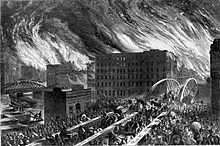
In 1871, the Great Chicago Fire broke out, destroying an area of about 4 miles long and 1 mile wide, a large section of the city at the time. Much of the city, including railroads and stockyards, survived intact, and from the ruins of the previous wooden structures arose more modern constructions of steel and stone which would set the precedent for worldwide construction. During its rebuilding period, Chicago constructed the world's first skyscraper in 1885, using steel-skeleton construction. Chicago's flourishing economy attracted huge numbers of new immigrants from Europe and migrants from the eastern states. Of the total population in 1900 not less than 77% were foreign-born, or born in the United States of foreign parentage. Germans, Irish, Poles, Swedes and Czechs made up nearly two-thirds of the foreign-born population (by 1900, whites were 98.1% of the city's population). Labor conflicts followed the industrial boom and the rapid expansion of the labor pool, including the Haymarket affair on May 4, 1886. Concern for social problems among Chicago's immigrant poor led Jane Addams to co aafound Hull House in 1889. Programs developed there became a model for the new field of social work.
During the 1870s and 1880s, Chicago attained national stature as the leader in the movement to improve public health. City, and later state laws, that upgraded standards for the medical profession and fought urban epidemics of cholera, small pox, and yellow fever were not only passed, but also enforced. These in turn became templates for public health reform in many other cities and states. The city invested in many large, well-landscaped municipal parks, which also included public sanitation facilities. The chief advocate and driving force for improving public health in Chicago was Dr. John H. Rauch, M.D., who established a plan for Chicago's park system in 1866, created Lincoln Park by closing a cemetery filled with festering, shallow graves, and helped establish a new Chicago Board of Health in 1867 in response to an outbreak of cholera. Ten years later he became the secretary and then the president of the first Illinois State Board of Health, which carried out most of its activities in Chicago.
In the 19th century, Chicago became the nation's railroad center, a title it still holds. In 1883, the standardized system of North American Time Zones was adopted by the general time convention of railway managers in Chicago. This gave the continent its uniform system for telling time.
In 1893, Chicago hosted the World's Columbian Exposition on former marshland at the present location of Jackson Park. The Exposition drew 27.5 million visitors, and is considered the most influential world's fair in history. The University of Chicago was founded in 1892 on the same South Side location. The term "midway" for a fair or carnival referred originally to the Midway Plaisance, a strip of park land that still runs through the University of Chicago campus and connects Washington and Jackson Parks.
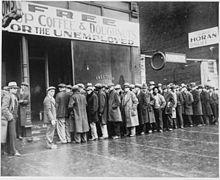
The capsizing of the Eastland steamer on the Chicago River in 1915 was Chicago's worst disaster, claiming 844 lives. The 1920s saw gangsters, including Al Capone, battle law enforcement and each other on the streets of Chicago during the Prohibition era. In 1924, Chicago was the first American city to have a homosexual-rights organization, the Society for Human Rights. This organization produced the first American publication for gays, Friendship and Freedom.
The 1920s also saw a major expansion in industry. The availability of jobs attracted blacks from the South. Between 1910 and 1930, the black population of Chicago dramatically increased from 44,103 to 233,903. Arriving in the hundreds of thousands during the Great Migration, the newcomers had an immense cultural impact. It was during this wave that Chicago became a center for jazz, with King Oliver leading the way.
In 1933, Chicago Mayor Anton Cermak was fatally wounded in Miami, Florida during a failed assassination attempt on President-elect Franklin D. Roosevelt. In 1933 and 1934, the city celebrated its centennial by hosting the Century of Progress International Exposition Worlds Fair. The theme of the fair was technological innovation over the century since Chicago's founding.

On December 2, 1942, physicist Enrico Fermi conducted the world's first controlled nuclear reaction at the University of Chicago as part of the top-secret Manhattan Project. This led to the creation of the atomic bomb by the United States, which it used in World War II in 1945.
Mayor Richard J. Daley, a Democrat, was elected in 1955, in the era of machine politics. Starting in the early 1960s due to blockbusting, many white residents, as in most American cities, left the city for the suburbs. Whole neighborhoods were completely changed based on race. Structural changes in industry caused heavy losses of jobs for lower skilled workers. In 1966, James Bevel, Martin Luther King, Jr., and Albert Raby led the Chicago Open Housing Movement, which culminated in agreements between Mayor Richard J. Daley and the movement leaders. Two years later, the city hosted the tumultuous 1968 Democratic National Convention, which featured physical confrontations both inside and outside the convention hall, including full-scale riots, or in some cases police riots, in city streets. Major construction projects, including the Sears Tower (now known as the Willis Tower, which in 1974 became the world's tallest building), University of Illinois at Chicago, McCormick Place, and O'Hare International Airport, were undertaken during Richard J. Daley's tenure. In 1979, Jane Byrne, the city's first female mayor, was elected. She popularized the city further as a movie location and tourist destination.
In 1983, Harold Washington became the first black mayor of the city of Chicago. Washington's first term in office saw attention given to poor and previously neglected minority neighborhoods. He was re aaelected in 1987 but died of a heart attack a short time later. The balance of Washington's second term was served by 6th ward Alderman Eugene Sawyer. Richard M. Daley, son of Richard J. Daley, was elected in 1989. His accomplishments included improvements to parks and creating incentives for sustainable development. After successfully standing for re-election five times, and becoming Chicago's longest serving mayor, Richard M. Daley announced he would step down at the end of his final term in 2011.
On February 23, 2011, former Illinois Congressman and White House Chief of Staff, Rahm Emanuel, won the municipal election to become mayor of Chicago, heavily beating five rivals with 55 percent of the vote. Emanuel was sworn in as Mayor on May 16, 2011.
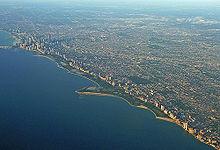
Chicago is located in northeastern Illinois on the southwestern shores of Lake Michigan. It is the principal city in Chicago Metropolitan Area situated in the Midwestern United States and the Great Lakes region. Chicago rests on a continental divide at the site of the Chicago Portage, connecting the Mississippi River and the Great Lakes watersheds. The city lies beside huge freshwater Lake Michigan, and two rivers aethe Chicago River in downtown and the Calumet River in the industrial far South Side aeflow entirely or partially through Chicago. Chicago is a world port city as the St Lawrence Seaway connects Lake Michigan with the Atlantic Ocean. The Chicago Sanitary and Ship Canal, which runs to the west of the City, connects the Chicago River with the Mississippi River, the fourth-longest river in the world. Chicago's history and economy are closely tied to its proximity to Lake Michigan. While the Chicago River historically handled much of the region's waterborne cargo, today's huge lake freighters use the city's Lake Calumet Harbor on the South Side. The lake also provides another positive effect, moderating Chicago's climate; making waterfront neighborhoods slightly warmer in winter and cooler in summer.
When Chicago was founded in 1833, most of the early building began around the mouth of the Chicago River, as can be seen on a map of the city's original 58 blocks. The overall grade of the city's central, built-up areas, is relatively consistent with the natural flatness of its overall natural geography, generally exhibiting only slight differentiation otherwise. The average land elevation is 579 ft (176 m) above sea level. The lowest points are along the lake shore at 577 ft (176 m), while the highest point, at 735 ft (224 m), is a landfill located in the Hegewisch community area on the city's far south side.
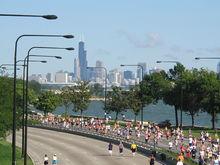
The Chicago Loop is the central business district, but Chicago is also a city of neighborhoods. Lake Shore Drive runs adjacent to a large portion of Chicago's lakefront. Some of the parks along the waterfront include Lincoln Park, Grant Park, Burnham Park and Jackson Park. 29 public beaches are also found along the shore. Landfill extends into portions of the lake providing space for Navy Pier, Northerly Island, the Museum Campus, and large portions of the McCormick Place Convention Center. Most of the city's high-rise commercial and residential buildings can be found close to the waterfront.
An informal name for the entire Chicago metropolitan area is "Chicagoland". There is no precise definition for the term "Chicagoland", but it generally means the city and its suburbs combined together. The Chicago Tribune, which coined the term, includes the city of Chicago, the rest of Cook County, eight nearby Illinois counties: Lake, McHenry, DuPage, Kane, Kendall, Grundy, Will and Kankakee, and three counties in Indiana: Lake, Porter and LaPorte. The Illinois Department of Tourism defines Chicagoland as Cook County without the city of Chicago, and only Lake, DuPage, Kane and Will counties. The Chicagoland Chamber of Commerce defines it as all of Cook and DuPage, Kane, Lake, McHenry and Will counties.
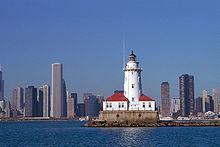
The city lies within the humid continental climate zone, and experiences four distinct seasons. Summers are hot and humid, with a July daily average of 84.7 °F (29.3 °C). In a normal summer, temperatures exceed 90 °F (32 °C) on 21 days. Winters are cold, snowy, and windy, with some sunny days, and with a January average of 23.5 °F ( na4.7 °C). Temperatures often (for 43 days on average) stay below freezing for an entire day, and lows below 0 °F ( na18 °C) occur on eight nights per year. Spring and Autumn are mild seasons with low humidity.
According to the National Weather Service, Chicago's highest official temperature reading of 107 °F (42 °C) was recorded on June 1, 1934, and July 11, 1936, both at Midway Airport. The lowest temperature of na27 °F ( na33 °C) was recorded on January 20, 1985, at O'Hare Airport. The city can experience extreme winter cold waves and summer heat waves that may last for several consecutive days. Severe weather is uncommon in the Chicago area, though there have been some exceptions such as the F4 tornado that devastated the south side of the city on April 21, 1967.


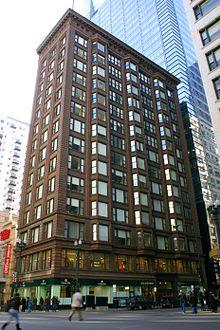
The destruction caused by the Great Chicago Fire led to the largest building boom in the history of the nation. In 1885, the first steel-framed high-rise building, the Home Insurance Building, rose in the city as Chicago ushered in the skyscraper era, which would then be followed by many other cities around the world. Today, Chicago's skyline is among the world's tallest and most dense. The United States' two tallest towers are both located in Chicago; Willis Tower (formerly Sears Tower, and the tallest building in the Western Hemisphere), and Trump International Hotel and Tower. The Loop's historic buildings include the Chicago Board of Trade Building, the Fine Arts Building, 35 East Wacker, and the Chicago Building, 860-880 Lake Shore Drive Apartments by Mies van der Rohe. Many other architects have left their impression on the Chicago skyline such as Daniel Burnham, Louis Sullivan, Charles B. Atwood, John Root, and Helmut Jahn. The Merchandise Mart, once first on the list of largest buildings in the world, and still listed as 20th, has its own zip code, and stands near the junction of the North and South branches of the Chicago River. Presently, the four tallest buildings in the city are Willis Tower (formerly the Sears Tower, also a building with its own zip code), Trump International Hotel and Tower, the Aon Center (previously the Standard Oil Building), and the John Hancock Center. Industrial districts, such as some areas on the South Side, the areas along the Chicago Sanitary and Ship Canal, and Northwest Indiana are clustered.
Chicago gave its name to the Chicago School and was home to the Prairie School, movements in architecture. Multiple kinds and scales of houses, townhouses, condominiums, and apartment buildings can be found throughout Chicago. Large swaths of the city's residential areas away from the lake are characterized by brick bungalows built from the early 20th century through the end of World War II. Chicago is also a prominent center of the Polish Cathedral style of church architecture. The Chicago suburb of Oak Park was home to famous architect Frank Lloyd Wright, who had designed The Robie House located near the University of Chicago as well as many prominent buildings across the country.
Unlike many Midwestern and East Coast cities, Chicago tends to have wider streets. A positive effect of this is that it alleviates the feeling of being engulfed by the city's large skyscrapers. Most of the city's residential streets also tend to have a wide patch of grass and/or trees between the street and the sidewalk itself. This has the effect of keeping pedestrians walking on the sidewalk further away from the street traffic. Chicago's Western Avenue is the longest continuous urban street in the world. Other famous streets include North Michigan Avenue, North State Street, Clark, and Belmont Avenue. The City Beautiful movement inspired Chicago's boulevards and parkways.
Chicago is famous for its outdoor public art, including works by Chagall, Picasso, Miro, and Abakanowicz.
City sculptures additionally honor the many people and topics reflecting the rich history of Chicago. There are monuments to:
There are also preliminary plans to erect a 1:1 aascale replica of WacÅaaw Szymanowski's Art Nouveau statue of Frederic Chopin found in Warsaw's Royal Baths along Chicago's lakefront in addition to a different sculpture commemorating the artist in Chopin Park for the 200th anniversary of Frederic Chopin's birth.
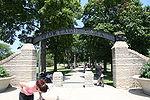
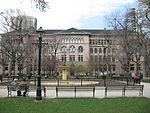
When Chicago was incorporated in 1837, it chose the motto Urbs in Horto, a Latin phrase which translates into English as "City in a Garden". Today, the Chicago Park District consists of 552 parks with over 7,300 acres (3,000 ha) of municipal parkland. There are 33 sand Chicago beaches, a plethora of museums, two world-class conservatories, 16 historic lagoons, and 10 bird and wildlife gardens. Lincoln Park, the largest of the city's parks, covers 1,200 acres (490 ha) and has over 20 million visitors each year, making it second only to Central Park in New York City in number of visitors. With berths for more than 5,000 boats, the Chicago Park District operates the nation's largest municipal harbor system; even larger than systems in cities such as New York City, Los Angeles, or Miami. In addition to ongoing beautification and renewal projects for the existing parks, a number of new parks have been added in recent years, such as the Ping Tom Memorial Park in Chinatown, DuSable Park on the Near North Side, and most notably, Millennium Park in a section of one of Chicago's oldest parks, Grant Park in the Chicago Loop.
The wealth of greenspace afforded by Chicago's parks is further augmented by the Cook County Forest Preserves, a network of open spaces containing forest, prairie, wetland, streams, and lakes that are set aside as natural areas which lie along the city's periphery, home to both the Chicago Botanic Garden in Glencoe and the Brookfield Zoo in Brookfield.
Chicago has four main sections: Downtown (which contains the Loop), the North Side, the South Side, and the West Side. The three sides of the city are represented on the Flag of Chicago by three horizontal white strips. These sections can further be informally subdivided or grouped, for example as shown on the map (right). Further sectional references are the Northwest side and the Southwest side. In the late 1920s, sociologists at the University of Chicago subdivided the city into 77 distinct community areas, which can further be subdivided into over 200 neighborhoods.
The central commercial area often is portrayed, as in the map at right, to include parts of Near North Side and Near South Side, as well as the Loop. The North Side is the most densely populated residential section of the city and many high-rises are located on this side of the city along the lakefront. The South Side is the largest section of the city, encompassing roughly 60% of the city's land area. The South Side contains the University of Chicago and most of the facilities of the Port of Chicago.
Chicago's streets were laid out in a street grid that grew from the city's original townsite plat. Streets following the Public Land Survey System section lines later became arterial streets in outlying sections. As new additions to the city were platted, city ordinance required them to be laid out with eight streets to the mile in one direction and sixteen in the other direction. The grid's regularity would provide an efficient means to develop new real estate property. A scattering of diagonal streets, many of them originally Indian trails, also cross the city. Many additional diagonal streets were recommended in the Plan of Chicago, but only the extension of Ogden Avenue was ever constructed.
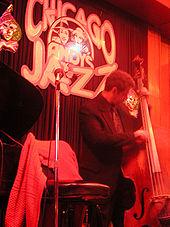
The city's waterfront allure and nightlife has attracted residents and tourists alike. Over one-third of the city population is concentrated in the lakefront neighborhoods (from Rogers Park in the north to South Shore in the south). The city has many upscale dining establishments as well as many ethnic restaurant districts. These districts include the Mexican villages, such as Pilsen along 18th street, and La Villita along 26th Street; the Puerto Rican enclave Paseo Boricua in the Humboldt Park neighborhood; "Greektown", along South Halsted St, immediately west of downtown; "Little Italy", along Taylor St; "Chinatown"; "Polish Patches"; "Little Seoul", around Lawrence Avenue; a cluster of Vietnamese restaurants along Argyle Avenue near Broadway, and Indian/Pakistani along Devon Avenue.
Downtown is the center of Chicago's financial, cultural, and commercial institutions and home to Grant Park and many of the city's skyscrapers. Many of the city's financial institutions (for example, CBOT, Chicago Fed) are located within a section of downtown called "The Loop", which is an eight-block by five-block square of city streets that are encircled by elevated rail tracks. The term "The Loop" is largely used by locals to refer to the entire downtown area as well. The central area includes the Near North Side, the Near South Side, and the Near West Side, as well as the Loop. These areas contribute famous skyscrapers, abundant restaurants, shopping, museums, a stadium for the Chicago Bears, convention facilities, parkland, and beaches.
The North Side is the most densely populated section of the city outside of downtown and many high-rises line this side of the city along the lakefront. Lincoln Park is a 1,200-acre (490 ha) park stretching for 5.5 mi (8.9 km) along the waterfront and containing the Lincoln Park Zoo and the Lincoln Park Conservatory. The River North neighborhood features the nation's largest concentration of contemporary art galleries outside of New York City. As a Polonia center, due to the city's having a very large Polish population, Chicago celebrates every Labor Day weekend at the Taste of Polonia Festival in the Jefferson Park area. The Chicago Cubs play in the North Side's Lakeview neighborhood, in the Wrigleyville district. Lakeview is also home to Boystown, which, along with Andersonville, are the best known LGBT neighborhoods.
The South Side is home to the University of Chicago (UC), ranked one of the world's top ten universities; and the Museum of Science and Industry. Burnham Park stretches along the waterfront of the South Side. Two of the city's largest parks are also located on this side of the city: Jackson Park, bordering the waterfront, hosted the World's Columbian Exposition in 1893, and is home of the aforementioned museum; and slightly west sits Washington Park. The two parks themselves are connected by a wide strip of parkland called the Midway Plaisance, running adjacent to the UC. The South Side hosts one of the city's largest parades, the annual African American Bud Billiken Day parade. The American automaker Ford Motor Company has an assembly plant located on the South Side, and most of the facilities of the Port of Chicago are here. The Chicago White Sox play in the South Side's Armour Square neighborhood.
The West Side holds the Garfield Park Conservatory, one of the largest collections of tropical plants in any US city. Prominent Latino cultural attractions found here include Humboldt Park's Institute of Puerto Rican Arts and Puerto Rican Day Parade, as well as the National Museum of Mexican Art and St. Adalbert's Church in Pilsen. The Near West Side holds the University of Illinois at Chicago and television production company of Oprah Winfrey's Harpo Studios. The Chicago Bulls and Chicago Blackhawks play on Madison Street.

Chicago's theatre community spawned modern improvisational theater. Two renowned comedy troupes emerged: The Second City and I.O. (formerly known as ImprovOlympic). Renowned Chicago theater companies include the Steppenwolf Theatre Company (on the city's north side), the Goodman Theatre, and the Victory Gardens Theater. Chicago offers Broadway-style entertainment at theaters such as Broadway In Chicago's Ford Center for the Performing Arts Oriental Theatre, Broadway In Chicago's Bank of America Theatre, Broadway In Chicago's Cadillac Palace Theatre, Auditorium Building of Roosevelt University, and Broadway In Chicago's Broadway Playhouse at Water Tower Place. Polish language productions for Chicago's large Polish speaking population can be seen at the historic Gateway Theatre in Jefferson Park. Since 1968, the Joseph Jefferson Awards are given annually to acknowledge excellence in theater in the Chicago area.
Classical music offerings include the Chicago Symphony Orchestra, recognized as one of the best orchestras in the world, which performs at Symphony Center. Also performing regularly at Symphony Center is the Chicago Sinfonietta, a more diverse and multicultural counterpart to the CSO. A new and interesting addition to the Chicago classical music scene is also the Renovo String Orchestra of Chicago. In the summer, many outdoor concerts are given in Grant Park and Millennium Park. Ravinia Park, located 25 miles (40 km) north of Chicago, is also a favorite destination for many Chicagoans, with performances occasionally given in Chicago locations such as the Harris Theater. The Civic Opera House is home to the Lyric Opera of Chicago. The Lithuanian Opera Company of Chicago was founded by Lithuanian Chicagoans in 1956, and presents operas in Lithuanian.
The Joffrey Ballet and Chicago Festival Ballet perform in various venues, including the Harris Theater in Millennium Park. Chicago is home to several other modern and jazz dance troupes, such as the Hubbard Street Dance Chicago.
Other live-music genre which are part of the city's cultural heritage include Chicago blues, Chicago soul, jazz, and gospel. The city is the birthplace of house music and is the site of an influential hip-hop scene. In the 1980s, the city was a center for industrial, punk and new wave. This influence continued into the alternative rock of the 1990s. The city has been an epicenter for rave culture since the 1980s. A flourishing independent rock music culture brought forth Chicago indie. Annual festivals feature various acts such as Lollapalooza and Pitchfork Music Festival.
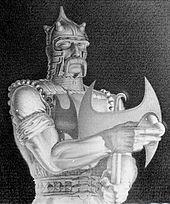
Chicago has a distinctive fine art tradition. For much of the twentieth century it nurtured a strong style of figurative surrealism, as in the works of Ivan Albright and Ed Paschke. In 1968 and 1969, members of the Chicago Imagists, such as Roger Brown, Leon Golub, Robert Lostutter, Jim Nutt, and Barbara Rossi produced bizarre representational paintings.
Chicago is home to a number of large, outdoor works by well-known artists. These include the Chicago Picasso, MirR³'s Chicago, Flamingo and Flying Dragon by Alexander Calder, Agora by Magdalena Abakanowicz, Monument with Standing Beast by Jean Dubuffet, Batcolumn by Claes Oldenburg, Cloud Gate by Anish Kapoor, Crown Fountain by Jaume Plensa, and the Four Seasons mosaic by Marc Chagall.
Chicago also has a nationally televised Thanksgiving parade that occurs annually. The McDonald's Thanksgiving Parade is seen across the nation on WGN-TV and WGN America, featuring a variety of diverse acts from the community, marching bands from across the country, and is the only balloon to feature inflatable balloons every year.
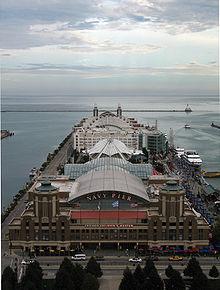
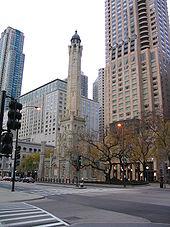
In 2008[update], Chicago attracted 32.4 million domestic leisure travelers, 11.7 million domestic business travelers and 1.3 million overseas visitors. These visitors contributed more than US$11.8 billion to Chicago's economy. Upscale shopping along the Magnificent Mile and State Street, thousands of restaurants, as well as Chicago's eminent architecture, continue to draw tourists. The city is the United States' third-largest convention destination. A 2011 study by Walk Score ranked Chicago the fourth most walkable of fifty largest cities in the United States. Most conventions are held at McCormick Place, just south of Soldier Field. The historic Chicago Cultural Center (1897), originally serving as the Chicago Public Library, now houses the city's Visitor Information Center, galleries and exhibit halls. The ceiling of its Preston Bradley Hall includes a 38 ft (12 m) Tiffany glass dome. Grant Park holds Millennium Park, Buckingham Fountain (1927), and the Art Institute of Chicago. The park also hosts the annual Taste of Chicago festival. In Millennium Park, there is the reflective Cloud Gate sculpture. Also, an outdoor restaurant transforms into an ice rink in the winter season. Two tall glass sculptures make up the Crown Fountain. The fountain's two towers display visual effects from LED images of Chicagoans' faces, along with water spouting from their lips. Frank Gehry's detailed, stainless steel band shell, the Jay Pritzker Pavilion, hosts the classical Grant Park Music Festival concert series. Behind the pavilion's stage is the Harris Theater for Music and Dance, an indoor venue for mid-sized performing arts companies, including the Chicago Opera Theater and Music of the Baroque.
Navy Pier, located just east of Streeterville, is 3,000 ft (910 m) long and houses retail stores, restaurants, museums, exhibition halls and auditoriums. Its 150-foot (46 m) tall Ferris wheel is one of the most visited landmarks in the Midwest, attracting about 8 million people annually. Chicago was the first city in the world to ever erect a ferris wheel.
On June 4, 1998, the city officially opened the Museum Campus, a 10-acre (4.0 ha) lakefront park, surrounding three of the city's main museums, each of which is of national importance: the Adler Planetarium & Astronomy Museum, the Field Museum of Natural History, and the Shedd Aquarium. The Museum Campus joins the southern section of Grant Park, which includes the renowned Art Institute of Chicago. Buckingham Fountain anchors the downtown park along the lakefront. The University of Chicago Oriental Institute has an extensive collection of ancient Egyptian and Near Eastern archaeological artifacts. Other museums and galleries in Chicago include the Chicago History Museum, the DuSable Museum of African American History, the Museum of Contemporary Art, the Peggy Notebaert Nature Museum, the Polish Museum of America, the Museum of Broadcast Communications and the Museum of Science and Industry.
The top activity while visitors tour Chicago for leisure is entertainment, approximately 33% of all leisure travelers. Facilities such as McCormick Place and the Chicago Theatre contribute to this percentage.
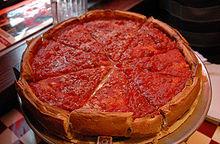
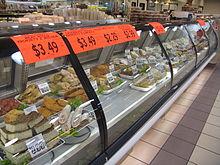
Chicago lays claim to a large number of regional specialties, all of which reflect the city's ethnic and working class roots. Included among these are its nationally renowned deep-dish pizza, this style is said to have originated at Pizzeria Uno. The Chicago-style thin crust is also popular in the city.
The Chicago-style hot dog, typically a Vienna Beef dog, is loaded with an array of fixings that often includes neon green pickle relish, yellow mustard, pickled sport peppers, tomato wedges, dill pickle spear and topped off with celery salt ae all on an S. Rosen's poppy seed bun. Enthusiasts of the Chicago-style dog frown upon the use of ketchup as a garnish, but may prefer to add giardiniera.
There are several distinctly Chicago sandwiches, among them the Italian beef sandwich, which is thinly sliced beef slowly simmered au jus and served on an Italian roll with sweet peppers or spicy giardiniera. A popular modification is the Combo aean Italian beef sandwich with the addition of an Italian sausage. Another is the Maxwell Street Polish, a grilled or deep-fried kielbasa ae on a hot dog roll, topped with grilled onions, yellow mustard, and hot sport peppers.
Ethnically originated creations include chicken Vesuvio, with roasted bone-in chicken cooked in oil and garlic next to garlicky oven-roasted potato wedges and a sprinkling of green peas. Another is the Puerto Rican-influenced jibarito, a sandwich made with flattened, fried green plantains instead of bread. There is also the tamale with chile, mother-in-law sandwich. Yet another is the Greek saganaki, an appetizer of cheese served flambe at the table.
The annual summer festival, the Taste of Chicago in Grant Park, highlights food in the city with many local restaurants taking part.
A number of well-known chefs have restaurants in Chicago, including Charlie Trotter, Rick Tramonto, Grant Achatz, and Rick Bayless. In 2003, Robb Report named Chicago the country's "most exceptional dining destination."
The city is home to 23 Michelin-starred restaurants, with one three-star restaurant, Alinea.
Chicago features a wide selection of vegetarian cuisine, with 22 fully vegetarian restaurants and many vegetarian-friendly establishments within the city.
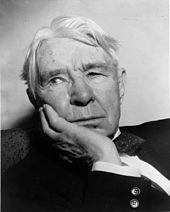
Chicago literature finds its roots in the city's tradition of lucid, direct journalism, lending to a strong tradition of social realism. In the Encyclopedia of Chicago, Northwestern University Professor Bill Savage describes Chicago fiction as prose which tries to "capture the essence of the city, its spaces and its people." The challenge for early writers was that Chicago was a frontier outpost that transformed into a global metropolis in the span of two generations. Narrative fiction of that time, much of it in the style of "high-flown romance" and "genteel realism", needed a new approach to describe the urban social, political, and economic conditions of Chicago. Nonetheless, Chicagoans worked hard to create a literary tradition that would stand the test of time, and create a "city of feeling" out of concrete, steel, vast lake, and open prairie. Much notable Chicago fiction focuses on the city itself, with social criticism keeping exultation in check.
At least, three short periods in the history of Chicago have had a lasting influence on American Literature. These include from the time of the Great Chicago Fire to about 1900, what became known as the Chicago Literary Renaissance in the 1910s and early 1920s, and the period of the Great Depression through the 1940s.
What would become the influential Poetry Magazine was founded in 1912 by Harriet Monroe, who was working as an art critic for the Chicago Tribune. The magazine discovered such poets as Gwendolyn Brooks, James Merrill, and John Ashbery. T. S. Eliot's first professionally published poem, "The Love Song of J. Alfred Prufrock", was first published by Poetry. Contributors have included Ezra Pound, William Butler Yeats, William Carlos Williams, Langston Hughes, and Carl Sandburg, among others. The magazine was instrumental in launching the Imagist and Objectivist poetic movements.
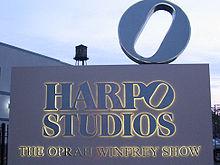
The Chicago metropolitan area is the third-largest media market in North America, after New York City and Los Angeles. Each of the big four U.S. television networks, CBS, ABC, NBC and Fox, directly owns and operates a high-definition television station in Chicago (WBBM, WLS, WMAQ and WFLD, respectively). WGN aaTV, which is owned by the Tribune Company, is carried with some programming differences, as "WGN America" on cable and satellite TV nationwide and in parts of the Caribbean. The city is also the home of several talk shows, including former The Oprah Winfrey Show on WLS aaTV, while Chicago Public Radio produces programs such as PRI's This American Life and NPR's Wait Wait...Don't Tell Me! Chicago's PBS station can be seen on WTTW, producer of shows, such as Sneak Previews, The Frugal Gourmet, Lamb Chop's Play-Along and The McLaughlin Group, just to name a few and WYCC.
There are two major daily newspapers published in Chicago: the Chicago Tribune and the Chicago Sun-Times, with the former having the larger circulation. There are also several regional and special-interest newspapers and magazines, such as Chicago, the Dziennik ZwiÄezkowy (Polish Daily News), Draugas (the Lithuanian daily newspaper), the Chicago Reader, the SouthtownStar, the Chicago Defender, the Daily Herald, Newcity, StreetWise and the Windy City Times. The entertainment and cultural magazine Time Out Chicago and GRAB Magazine are also published in the city.
Chicago is a filming-friendly location. Since the 1980s, many motion pictures have been filmed in the city, most notably The Blues Brothers; Ferris Bueller's Day Off; Home Alone; The Fugitive; I, Robot; Wanted; Batman Begins; The Dark Knight; and Transformers: Dark of the Moon.
Chicago has also been the setting for many popular television shows. Chicago-based TV shows include the situation comedies Perfect Strangers, its spinoff Family Matters, Married...with Children and The Bob Newhart Show. The city served as the venue for the medical dramas ER and Chicago Hope, as well as the fantasy drama series Early Edition and 2005 ae2009 drama Prison Break. The Good Wife is also set in Chicago. It is also the setting for Glee's 2012 Nationals Show Choir Competition. Discovery Channel films two shows in Chicago: Cook County Jail and the Chicago version of Cash Cab. Chicago is currently the setting of ABC sitcom Happy Endings.
Chicago is also home to a number of national radio shows, including Beyond the Beltway with Bruce DuMont on Sunday evenings. Midtown Madness 2, a real-life, car-driving simulation game is based on Chicago.
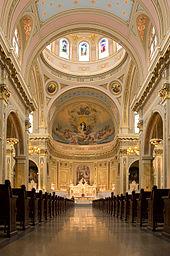
Christianity is predominant among the city's population. The Chicago Metropolitan Area also includes adherents of Judaism, Islam, Buddhism, Hinduism, Jainism, Sikhism, and the BahR¡'R, among others.
The wealth of Chicago's religious heritage is evident in its many noted examples of sacred architecture and institutions. Many of these religious edifices are Christian in origin, with Roman Catholic structures particularly prevalent. However, the city of Polish Cathedrals is rife with numerous historic synagogues, as well as the noteworthy sacred spaces of other religions. Chicago's northern suburb of Wilmette, Illinois, is the BahR¡'R Temple, the only temple for the BahR¡'R Faith in North America.
The city played host to the first two Parliament of the World's Religions in 1893 and 1993. Chicago contains many theological institutions, which include seminaries and colleges such as the Moody Bible Institute and DePaul University. Chicago is the seat of numerous religious leaders from a host of bishops of a wide array of Christian denominations as well as other religions.
Many international religious leaders have visited Chicago, including Mother Teresa and the Dalai Lama. Pope John Paul II visited Chicago in 1979 during his first trip ever to the United States after being elected to the Papacy in 1978.
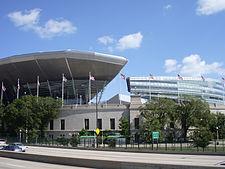
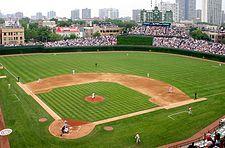
Chicago was named the Best Sports City in the United States by The Sporting News in 1993, 2006, 2010. The city is home to two Major League Baseball (MLB) teams: the Chicago Cubs of the National League (NL), who play in Wrigley Field on the North Side; and the Chicago White Sox of the American League (AL), who play in U.S. Cellular Field on the South Side. Chicago is the only city that has had more than one MLB franchise every year since the AL began in 1901. The Chicago Bears, one of the last two remaining charter members of the National Football League (NFL), have won nine NFL Championships, including Super Bowl XX. The other remaining charter franchise, the Chicago Cardinals, also started out in the city, but are now known as the Arizona Cardinals. The Bears play their home games at Soldier Field just off the shore of Lake Michigan. Once a home to stock car racing, Soldier field was an aging stadium and was in dire need of renovation by the end of the 20th century. In 2003, Soldier Field re-opened after an extensive renovation, which increased the number of luxury boxes in the stadium and dramatically improved the day of game experience for Bears fans.
The Chicago Bulls of the National Basketball Association (NBA) are one of the most recognized basketball teams in the world. During the 1990s with Michael Jordan leading them, the Bulls took six NBA championships in eight seasons. The Chicago Blackhawks of the National Hockey League (NHL), who began play in 1926, and are one of the "Original Six", teams of the National Hockey League (NHL), have won four Stanley Cups. The Blackhawks are the 2010 Stanley Cup champions, and hosted the 2009 NHL Winter Classic at Wrigley Field. Both the Bulls and Blackhawks play at the United Center on the Near West Side. The Chicago Rush has been a member of the Arena Football League since 2001 and won ArenaBowl XX, playing in suburban Rosemont. The Arena Football League front office is also in Chicago. The Chicago Fire are members of Major League Soccer (MLS) and reside at Toyota Park in suburban Bridgeview, after playing its first eight seasons at Soldier Field. The Fire have won one league title and four U.S. Open Cups since their founding in 1997.
While four of the five major franchises have won championships within recent time ae the Bears (1985), the Bulls (91, '92, '93, '96, '97, and '98), the White Sox (2005), and the Blackhawks (2010) ae the Chicago Cubs are known for their drought of over 100 years without a championship (currently 103 years as of the 2011 MLB season). The last time the Cubs were in a World Series was 1945. Some fans claim the Curse of the Billy Goat is responsible for the drought.
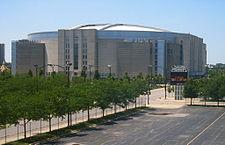
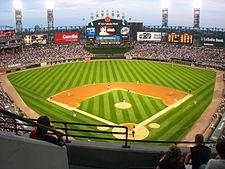
The Chicago Marathon has been held each year since 1977 except for in 1987, when a half marathon was run in its place. The Chicago Marathon is one of five World Marathon Majors. In 1994, the United States hosted a successful FIFA World Cup with games played at Soldier Field on Chicago's downtown lakefront.
After a months' long process that saw the elimination of several American and international cities, Chicago was selected on April 14, 2007, to represent the United States internationally in the bidding for the 2016 Summer Olympics. Chicago had previously hosted the 1959 Pan American Games and the 2006 Gay Games. Chicago was selected to host the 1904 Olympics, but they were transferred to St. Louis to coincide with the World's Fair. On June 4, 2008, the International Olympic Committee narrowed the field further and selected Chicago as one of four candidate cities for the 2016 games. On October 2, 2009, Rio de Janeiro was selected as the host city, with Chicago being eliminated in the first round of voting.
Starting just off Navy Pier is Chicago Yacht Club's Race to Mackinac, a 330-mile (530 km) offshore sailboat race held each July that is the longest annual freshwater sailing distance race in the world. 2010 marks the 102nd running of the "Mac".
Five area colleges play in Division I conferences: DePaul University (Big East Conference), Northwestern University (Big Ten Conference), Chicago State University (Great West Conference), Loyola University Chicago (Horizon League), and the University of Illinois at Chicago (Horizon League).
See also: List of companies in the Chicago metropolitan area
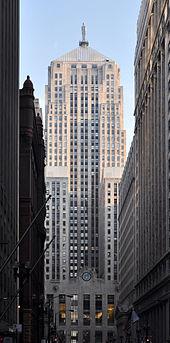
Chicago has the third largest gross metropolitan product in the United States aeapproximately $532 billion according to 2010 estimates, after only the urban agglomerations of New York City and Los Angeles, in the first and second place, respectively. The city has also been rated as having the most balanced economy in the United States, due to its high level of diversification. Chicago was named the fourth most important business center in the world in the MasterCard Worldwide Centers of Commerce Index. Additionally, the Chicago metropolitan area recorded the greatest number of new or expanded corporate facilities in the United States for six out of the seven years from 2001 to 2008. The Chicago metropolitan area has the third largest science and engineering work force of any metropolitan area in the nation. In 2009 Chicago placed 9th on the UBS list of the world's richest cities. Chicago was the base of commercial operations for industrialists John Crerar, John Whitfield Bunn, Richard Teller Crane, Marshall Field, John Farwell, Morris Selz, Julius Rosenwald and many other commercial visionaries who laid the foundation for Midwestern and global industry.
Chicago is a major world financial center, with the second largest central business district in the United States. The city is the headquarters of the Federal Reserve Bank of Chicago (the Seventh District of the Federal Reserve). The city is also home to major financial and futures exchanges, including the Chicago Stock Exchange, the Chicago Board Options Exchange (CBOE), and the Chicago Mercantile Exchange (the "Merc"), which is owned, along with the Chicago Board of Trade (CBOT) by Chicago's CME Group. The CME Group, in addition, owns the New York Mercantile Exchange (NYMEX), the Commodities Exchange Inc. (COMEX) and the Dow Jones Indexes. Perhaps due to the influence of the Chicago school of economics, the city also has markets trading unusual contracts such as emissions (on the Chicago Climate Exchange) and equity style indices (on the U.S. Futures Exchange). Chase Bank has its commercial and retail banking headquarters in Chicago's Chase Tower.
The city and its surrounding metropolitan area are home to the second largest labor pool in the United States with approximately 4.25 million workers. In addition, the state of Illinois is home to 66 Fortune 1000 companies, including those in Chicago. The city of Chicago also hosts 12 Fortune Global 500 companies and 17 Financial Times 500 companies. The city claims one Dow 30 company: aerospace giant Boeing, which moved its headquarters from Seattle to the Chicago Loop in 2001. Two more Dow 30 companies, Kraft Foods and McDonalds. are in Chicago suburbs, as are Sears Holdings Corporation and the technology spin-offs of Motorola. Chicago is also home to United Continental Holdings, with headquarters in the United Building and operations center at Willis Tower, and its United Airlines subsidiary.
Manufacturing, printing, publishing and food processing also play major roles in the city's economy. Several medical products and services companies are headquartered in the Chicago area, including Baxter International, Boeing, Abbott Laboratories, and the Healthcare Financial Services division of General Electric. Moreover, the construction of the Illinois and Michigan Canal, which helped move goods from the Great Lakes south on the Mississippi River, and of the railroads in the 19th century made the city a major transportation center in the United States. In the 1840s, Chicago became a major grain port, and in the 1850s and 1860s Chicago's pork and beef industry expanded. As the major meat companies grew in Chicago many, such as Armour and Company, created global enterprises. Though the meatpacking industry currently plays a lesser role in the city's economy, Chicago continues to be a major transportation and distribution center. Lured by a combination of large business customers, federal research dollars, and a large hiring pool fed by the area's universities, Chicago is also home to a growing number of web startup companies like CareerBuilder, Orbitz, 37signals, Groupon, and Feedburner.
Chicago has been a hub of the Retail sector since its early development in America, when it was the home of Montgomery Ward, Sears, and Marshall Field's. Today the Chicago metro area is the home of several retailers, including Walgreens, Sears, OfficeMax, Ace Hardware, Claire's, and Crate & Barrel.
Late in the 19th century, Chicago was part of the bicycle craze, as home to Western Wheel Company, which introduced stamping to the production process and significantly reduced costs, while early in the 20th century, the city was part of the automobile revolution, hosting the Brass Era car builder Bugmobile, which was founded there in 1907. Chicago was also home to the Schwinn Bicycle Company.
Chicago is a major world convention destination. The city's main convention center is McCormick Place. With its four interconnected buildings, it is the largest convention center in the nation and third largest in the world. Chicago also ranks third in the U.S. (behind Las Vegas and Orlando) in number of conventions hosted annually.
In June 2012, Chicago had 391,000 unemployed with a 9.4% unemployment rate against a national average of 8.2%.
During its first 100 years, Chicago was one of the fastest-growing cities in the world. When founded in 1833, less than 200 people had settled on what was then the American frontier. By the time of its first census, seven years later, the population had reached over 4,000. Within the span of forty years, the city's population grew from slightly under 30,000 in 1850 to over 1 million by 1890. By the close of the 19th century, Chicago was the fifth largest city in the world,[100] and the largest of the cities that did not exist at the dawn of the century. Within sixty years of the Great Chicago Fire of 1871, the population went from about 300,000 to over 3 million,[101] and reached its highest ever-recorded population of 3.6 million for the 1950 census.
From the last two decades of the 19th Century, Chicago was the destination of waves of immigrants from Southern and Eastern Europe, including (but by no means limited to) Italians, Jews, Poles, and Czechs.[102] To these ethnic groups, the basis of the city's industrial working class, was added an additional influx of African-Americans from the American South ae with Chicago's black population doubling between 1910 and 1920 and doubling again between 1920 and 1930.[102]
The great majority of American blacks moving to Chicago in these years were clustered in a so aacalled "Black Belt" on the city's South Side.[102] By 1930, two-thirds of Chicago's African-American population lived in sections of the city which were 90% black in racial composition.[102] Chicago's South Side emerged as America's second largest urban black concentration, following New York's Harlem.[102]
As of the 2010 census,[103] there were 2,695,598 people with 1,045,560 households living in Chicago. More than half the population of the state of Illinois lives in the Chicago metropolitan area. Chicago is also one of the United States' most densely populated major cities. The racial composition of the city was:
Chicago has a Hispanic or Latino population of 28.9%. (Its members may belong to any race; 21.4% Mexican, 3.8% Puerto Rican, 0.7% Guatemalan, 0.6% Ecuadorian, 0.3% Cuban, 0.3% Colombian, 0.2% Honduran, 0.2% Salvadoran, 0.2% Peruvian)[104] The Guatemalan, Colombian and Peruvian communities have skyrocketed in the 2000s, and some estimates give higher percentages.
Based on Census data from 2000, the median income for a household in the city was $38,625, and the median income for a family was $42,724. Males had a median income of $35,907 versus $30,536 for females. About 16.6% of families and 19.6% of the population lived below the poverty line.[105]
The city's most populous ethnic group, non-Hispanic white, has declined from 59% in 1970 to 31.7% in 2010.[106] As of the 2007 US Census American Community Survey the largest European ancestries were:
According to the 2008 American Community Survey 1-Year Estimates for Total Ancestry Reported, for the city of Chicago, the majority of residents, or 64% of 2,986,974 people, reported their ancestry as "other groups".[108] Of the 36% of residents that reported their ancestries in groups that were measured by the U.S. Census Bureau, the largest groups, based on the total population, were: Irish (6.6%); German (6.5%); Polish (5.3%); Italian (3.5%); Assyrian (3.5%); English (2.0%); Sub-Saharan African (1.2%); American (1.1%); Filipino (1.0%); Russian (0.97%); Swedish (0.91%); French (except Basque) (0.9%); Arab (0.7%); Greek (0.6%); Dutch (0.5%); Norwegian (0.5%); Scottish (0.5%); European (0.5%); West Indian (0.5%); Lithuanian (0.4%); Ukrainian (0.38%); Czech (0.4%); Hungarian (0.3%); Scotch-Irish (0.2%); Welsh (0.2%); Danish (0.2%); French Canadian (0.2%); Slovak (0.2%); British (0.1%); Swiss (0.1%); and Portuguese (0.1%).[108] The city also has a large Assyrian population numbering between 80,000 ae120,000, and it is the location of the seat of the head of the Assyrian Church of the East, Mar Dinkha IV. [109]
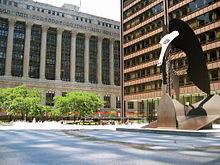
Chicago is the county seat of Cook County. The government of the City of Chicago is divided into executive and legislative branches. Civil and criminal law cases are heard in the Cook County Circuit Court of the State of Illinois court system, or in the Northern District of Illinois, in the federal system. In the former, the public prosecutor is the Illinois State's Attorney, in the latter, the United States Attorney.
The Mayor of Chicago is the chief executive, elected by general election for a term of four years, with no term limits. The mayor appoints commissioners and other officials who oversee the various departments. In addition to the mayor, Chicago's two other citywide elected officials are the clerk and the treasurer. The City Council is the legislative branch and is made up of 50 aldermen, one elected from each ward in the city. The council enacts local ordinances and approves the city budget. Government priorities and activities are established in a budget ordinance usually adopted each November. The council takes official action through the passage of ordinances and resolutions.
During much of the last half of the 19th century, Chicago's politics were dominated by a growing Democratic Party organization dominated by ethnic ward-heelers. During the 1880s and 1890s, Chicago had a powerful radical tradition with large and highly organized socialist, anarchist and labor organizations.[110] For much of the 20th century, Chicago has been among the largest and most reliable Democratic strongholds in the United States; with Chicago's Democratic vote the state of Illinois has been "solid blue" in presidential elections since 1992. Even before then, it was not unheard of for Republican presidential candidates to win handily in downstate Illinois, only to lose statewide due to large Democratic margins in Chicago. The citizens of Chicago have not elected a Republican mayor since 1927, when William Thompson was voted into office. The strength of the party in the city is partly a consequence of Illinois state politics, where the Republicans have come to represent the rural and farm concerns while the Democrats support urban issues such as Chicago's public school funding. Chicago contains less than 25% of the state's population, but 8 of Illinois' 19 U.S. Representatives have part of Chicago in their districts.
Former Chicago Mayor Richard J. Daley's (in office 1955 ae1976) mastery of machine politics preserved the Chicago Democratic Machine long after the demise of similar machines in other large U.S. cities.[111] During much of that time, the city administration found opposition mainly from a liberal "independent" faction of the Democratic Party. The independents finally gained control of city government in 1983 with the election of Harold Washington (in office 1983 ae1987). From 1989 until May 16, 2011, Chicago was under the leadership of its longest serving mayor, Richard M. Daley, the son of Richard J. Daley. On May 16, 2011, Rahm Emanuel was sworn in as the 55th mayor of Chicago. Because of the dominance of the Democratic Party in Chicago, the Democratic primary vote held in the spring is generally more significant than the general elections in November for U.S. House and Illinois State seats. The aldermanic, mayoral, and other city offices are filled through nonpartisan elections with runoffs as needed.
Murders in the city peaked first in 1974, with 970 murders when the city's population was over 3 million people (resulting in a murder rate of around 29 per 100,000), and again in 1992 with 943 murders, resulting in a murder rate of 34 per 100,000.[112] Chicago, along with other major US cities, experienced a significant reduction in violent crime rates through the 1990s, eventually recording 448 homicides in 2004, the lowest total since 1965 (15.65 per 100,000.) Chicago's homicide tally remained steady throughout 2005, 2006, and 2007 with 449, 452, and 435 respectively.
In 2008, murders rebounded to 510, 2nd highest in the country (though not in per capita rate), breaking 500 for the first time since 2003.[113][114] For 2009 the murder count was down about 10% for the year, to 458.[115]
2010 saw Chicago's murder rate at its lowest levels since 1965. Overall, 435 homicides were recorded for the year, a 5% decrease from 2009.[116]
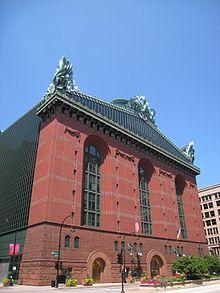
There are 675 public schools,[117] 394 private schools, 83 colleges, and 88 libraries in Chicago. Chicago Public Schools (CPS) is the governing body of the school district that contains over 600 public elementary and high schools citywide, including several selective-admission magnet schools. There are 9 selective enrollment high schools in the Chicago Public Schools. They are designed to meet the needs of Chicago aos most academically advanced students. The schools offer a rigorous curriculum with mainly honors and Advanced Placement (AP) courses.[118] Northside College Preparatory High School is ranked number one in the city of Chicago. The oldest magnet school in the City of Chicago, Whitney M. Young Magnet High School, was opened in 1975, was attended by the First Lady of the United States, Michelle Obama, and ranked number two.Walter Payton College Prep High School is ranked number three. The Chicago high school rankings are determined by the average test scores on state achievement tests.[119] The district, with an enrollment exceeding 400,000 students (2005 stat.), ranks as the third largest in the US[120] On September 10, 2012, teachers for the Chicago Teachers Union went on strike for the first time since 1987 over pay, resources and other issues.[121]
Chicago's private schools are largely Catholic and Lutheran schools. The Roman Catholic Archdiocese of Chicago operates the city's Catholic schools, including the Jesuit preparatory schools. Some of the more prominent Catholic schools are St. Rita of Cascia High School, De La Salle Institute, Gordon Technical High School, Cristo Rey Jesuit High School, Brother Rice High School, St. Ignatius College Preparatory School, St. Scholastica Academy, Mount Carmel High School, Mother McAuley Liberal Arts High School, Marist High School, St. Patrick High School, Maria High School and Resurrection High School. In addition to Chicago's network of 32 Lutheran schools,[122] there are also several private schools run by other denominations and faiths, such as the Ida Crown Jewish Academy in West Ridge. Additionally, a number of private schools are run in a completely secular educational environment, such as the Latin School of Chicago, the University of Chicago Laboratory Schools in Hyde Park,the Siebel Institute of brewing tech, the Francis W. Parker School, the Chicago City Day School in Lake View, the Feltre School in River North and the Morgan Park Academy. Chicago is also home of the private Chicago Academy for the Arts, a high school focused on six different categories of the arts, such as Media Arts, Visual Arts, Music, Dance, Musical Theatre and Theatre.
The Chicago Public Library system operates 79 public libraries including the central library, two regional libraries, and numerous branches distributed throughout the city.
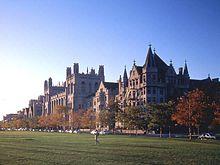
Since the 1850s, Chicago has been a world center of higher education and research with several universities that are in the city proper or in the immediate environs. These institutions consistently rank among the top "National Universities" in the United States, as determined by U.S. News & World Report. Top universities in Chicago are: The University of Chicago; Northwestern University; Illinois Institute of Technology; Loyola University Chicago; DePaul University; and University of Illinois at Chicago.[123] Other notable schools include: Chicago State University; the School of the Art Institute of Chicago, the Illinois Institute of Art - Chicago; East aeWest University; National-Louis University; North Park University; Northeastern Illinois University; Columbia College Chicago; Robert Morris University; Roosevelt University; Saint Xavier University; and Rush University.
William Rainey Harper, the first president of the University of Chicago, was instrumental in the creation of the junior college concept, establishing nearby Joliet Junior College as the first in the nation in 1901.[124] His legacy continues with the multiple community colleges in the Chicago proper, including the seven City Colleges of Chicago, Richard J. Daley College, Kennedy aeKing College, Malcolm X College, Olive aeHarvey College, Harry S Truman College, Harold Washington College and Wilbur Wright College, in addition to the privately held MacCormac College.
Chicago proper also has a large concentration of graduate schools, seminaries and theological schools such as the Adler School of Professional Psychology, The Chicago School of Professional Psychology, the Catholic Theological Union, Moody Bible Institute, and the University of Chicago Divinity School.
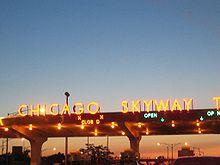
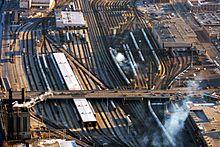
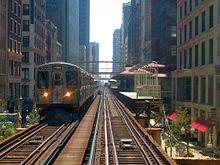
Chicago is a major transportation hub in the United States. It is an important component in global distribution, as it is the third largest inter-modal port in the world after Hong Kong and Singapore.[125]
Seven mainline and four auxiliary interstate highways (55, 57, 65 (only in Indiana), 80 (also in Indiana), 88, 90 (also in Indiana), 94 (also in Indiana), 190, 290, 294, and 355) run through Chicago and its suburbs. Segments that link to the city center are named after influential politicians, with three of them named after former U.S. Presidents (Eisenhower, Kennedy, and Reagan) and one named after two-time Democratic candidate Adlai Stevenson.
The Kennedy and Dan Ryan Expressways are the busiest state maintained routes in not only the City of Chicago and its suburbs, but also the entire state of Illinois.[126]
The Regional Transportation Authority (RTA) coordinates the operation of the three service boards: CTA, Metra, and Pace.
Greyhound Lines provides inter-city bus service to and from the city, and Chicago is also the hub for the Midwest network of Megabus (North America).
Amtrak long distance services originate from Union Station. Chicago is one of the largest hubs of passenger rail service in the nation. The services terminate in San Francisco, Washington, D.C., New York City, Indianapolis, New Orleans, Portland, Seattle, Milwaukee, Quincy, St. Louis, Carbondale, Boston, Grand Rapids, Port Huron, Pontiac, Los Angeles, and San Antonio. An attempt was made in the early 20th century to link Chicago with New York City via the Chicago ae New York Electric Air Line Railroad. Parts of this were built, but it was ultimately never completed.
Six of the seven Class I railroads meet in Chicago, with the exception being the Kansas City Southern Railway.[128] As of 2002, severe freight train congestion caused trains to take as long to get through the Chicago region as it took to get there from the West Coast of the country (about 2 days).[129] About one-third of the country's freight trains pass through the city, making it a major national bottleneck.[130] Announced in 2003, the Chicago Region Environmental and Transportation Efficiency (CREATE) initiative is using about $1.5 billion in private railroad, state, local, and federal funding to improve rail infrastructure in the region to reduce freight rail congestion by about one third.[131]
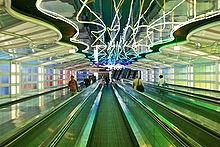
Chicago is served by O'Hare International Airport, the world's second busiest airport, on the far Northwest Side, and Midway International Airport on the Southwest Side. In 2005, O'Hare was the world's busiest airport by aircraft movements and the second busiest by total passenger traffic (due to government enforced flight caps).[132] Both O'Hare and Midway are owned and operated by the City of Chicago. Gary/Chicago International Airport and Chicago Rockford International Airport, located in Gary, Indiana and Rockford, Illinois, respectively, can serve as alternate Chicago area airports, however they do not offer as many commercial flights as O'Hare and Midway. Both Gary and Rockford are vying to become Chicago's third major airport, although the state of Illinois in recent years has been leaning towards building an entirely new airport in the Illinois suburbs of Chicago. The City of Chicago is the world headquarters for United Airlines, the world's largest airline. O'Hare is also a hub for American Airlines. Chicago is a focus city for Southwest Airlines at Midway.
The Port of Chicago consists of several major port facilities within the city of Chicago operated by the Illinois International Port District (formerly known as the Chicago Regional Port District). The central element of the Port District, Calumet Harbor, is maintained by the U.S. Army Corps of Engineers.[133]
Electricity for most of northern Illinois is provided by Commonwealth Edison, also known as ComEd. Their service territory borders Iroquois County to the south, the Wisconsin border to the north, the Iowa border to the west and the Indiana border to the east. In northern Illinois, ComEd (a division of Exelon) operates the greatest number of nuclear generating plants in any US state. Because of this, ComEd reports indicate that Chicago receives about 75% of its electricity from nuclear power. Recently, the city started the installation of wind turbines on government buildings with the aim to promote the use of renewable energy.[134][135][136]
Natural Gas is provided by Peoples Gas, a subsidiary of Integrys Energy Group, which is headquartered in Chicago.
Domestic and industrial waste was once incinerated but it is now landfilled, mainly in the Calumet area. From 1995 to 2008, the city had a blue bag program to divert certain refuse from landfills.[137] In the fall of 2007 the city began a pilot program for blue bin recycling similar to that of other cities due to low participation rates in the blue bag program. After completion of the pilot the city will determine whether to roll it out to all wards.
Using only 3% of the total available bandwidth capacity and 13% of the available fiber pairs, Chicago area data centers move data for local, area, regional and international networks.
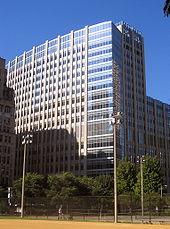
Chicago is home to the Illinois Medical District, on the Near West Side. It includes Rush University Medical Center, the University of Illinois Medical Center at Chicago, Jesse Brown VA Hospital, and John H. Stroger, Jr. Hospital of Cook County, the largest trauma-center in the city.
Two of the country's premier academic medical centers reside in Chicago, including Northwestern Memorial Hospital and the University of Chicago Medical Center. The Chicago campus of Northwestern University includes the Feinberg School of Medicine; Northwestern Memorial Hospital, which is ranked as the best hospital in the Chicago metropolitan area by U.S. News & World Report for 2010 ae11;[138] the Rehabilitation Institute of Chicago, which is ranked the best U.S. rehabilitation hospital by U.S. News & World Report; the new Prentice Women's Hospital; and Ann & Robert H. Lurie Children's Hospital of Chicago.
The University of Illinois College of Medicine at UIC is the largest medical school in the United States (2,600 students including those at campuses in Peoria, Rockford and Urbana aeChampaign).[139]
In addition, the Chicago Medical School and Loyola University Chicago's Stritch School of Medicine are located in the suburbs of North Chicago and Maywood, respectively. The Midwestern University Chicago College of Osteopathic Medicine is in Downers Grove.
The American Medical Association, Accreditation Council for Graduate Medical Education, Accreditation Council for Continuing Medical Education, American Osteopathic Association, American Dental Association, Academy of General Dentistry, American Dietetic Association, American Association of Nurse Anesthetists, American College of Surgeons, American Society for Clinical Pathology, American College of Healthcare Executives and the American Hospital Association, and Blue Cross and Blue Shield Association are all based in Chicago.
Chicago has 28 Sister Cities around the world.[140] Like Chicago, many of them are or were the second most populous city or second most influential city of their country, or they are the main city of a country that has had large amounts of immigrants settle in Chicago. Paris is a Partner City, due to the one sister city policy of its respective French commune.[141]
To celebrate the sister cities, Chicago hosts a yearly festival in Daley Plaza, which features cultural acts and food tastings from the other cities.[140] In addition, the Chicago Sister Cities program hosts a number of delegation and formal exchanges.[140] In some cases, these exchanges have led to further informal collaborations, such as the academic relationship between the Buehler Center on Aging, Health & Society at the Feinberg School of Medicine of Northwestern University and the Institute of Gerontology of Ukraine (originally of the Soviet Union), that was originally established as part of the Chicago-Kiev sister cities program.[142]
Sister Cities
Partner City


Word Count: 12338






